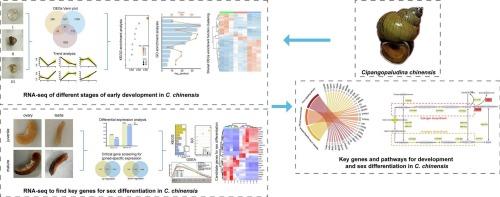Transcriptomic analysis unveils critical genes governing early development and sex differentiation in the Cipangopaludina chinensis (Gastropoda: Viviparidae)
IF 2.2
2区 生物学
Q4 BIOCHEMISTRY & MOLECULAR BIOLOGY
Comparative Biochemistry and Physiology D-Genomics & Proteomics
Pub Date : 2025-07-30
DOI:10.1016/j.cbd.2025.101590
引用次数: 0
Abstract
The Cipangopaludina chinensis is a freshwater species of great economic value in the class Gastropoda. The research on the development of the larvae of this species and the subsequent sex differentiation mechanism is extremely limited. This study conducted transcriptome analysis on C. chinensis juveniles at various early developmental stages, as well as on their gonads before and after sexual maturity. The results indicated that during the early stages of juvenile development, key biological pathways associated with growth encompassed the meiotic cell cycle, mitotic cell cycle, and multicellular organism development. Differentially expressed genes in the pathway that were highly correlated with development include DNMT1, OGG1, MCM, WDHD1 and OGT. Combining the results of protein-protein interactions and sex differentiation-related gene family analyses, we screened candidate genes SYCP1, TUBGCP3, CDK1, and STMN1 associated with testis development, and candidate genes DAX1, β-catenin, Foxl2, and CYP3A associated with ovarian development. This study enhances our understanding of early development and sex differentiation mechanisms in C. chinensis, which provides basic research for subsequent use of molecular means to intervene in its sex ratio and improve reproductive efficiency.

转录组学分析揭示了控制中国大腹足动物早期发育和性别分化的关键基因。
中国松柏是腹足纲一种具有重要经济价值的淡水物种。对该物种幼虫的发育和随后的性别分化机制的研究非常有限。本研究对中华月子(c.c chinensis)不同早期发育阶段的幼鱼以及性成熟前后的性腺进行了转录组分析。结果表明,在幼体发育早期,与生长相关的关键生物学途径包括减数分裂细胞周期、有丝分裂细胞周期和多细胞生物发育。该通路中与发育高度相关的差异表达基因包括DNMT1、OGG1、MCM、WDHD1和OGT。结合蛋白-蛋白相互作用和性别分化相关基因家族分析结果,我们筛选了与睾丸发育相关的候选基因SYCP1、TUBGCP3、CDK1和STMN1,以及与卵巢发育相关的候选基因DAX1、β-catenin、Foxl2和CYP3A。本研究加深了我们对中华月子早期发育和性别分化机制的认识,为后续利用分子手段干预其性别比、提高生殖效率提供了基础研究。
本文章由计算机程序翻译,如有差异,请以英文原文为准。
求助全文
约1分钟内获得全文
求助全文
来源期刊
CiteScore
5.10
自引率
3.30%
发文量
69
审稿时长
33 days
期刊介绍:
Comparative Biochemistry & Physiology (CBP) publishes papers in comparative, environmental and evolutionary physiology.
Part D: Genomics and Proteomics (CBPD), focuses on “omics” approaches to physiology, including comparative and functional genomics, metagenomics, transcriptomics, proteomics, metabolomics, and lipidomics. Most studies employ “omics” and/or system biology to test specific hypotheses about molecular and biochemical mechanisms underlying physiological responses to the environment. We encourage papers that address fundamental questions in comparative physiology and biochemistry rather than studies with a focus that is purely technical, methodological or descriptive in nature.

 求助内容:
求助内容: 应助结果提醒方式:
应助结果提醒方式:


